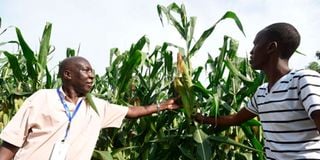The ABCs of scouting a maize crop

Perkerra Irrigation Scheme workers in Marigat on their maize plantation in 2021.
In the last article, we looked at diseases that affect maize during production. In this article, we look at scouting as a practice that any farmer must embrace for sustainable production.
Scouting refers to the process of identification, monitoring or recording of pests, diseases, weeds, water and nutritional requirements to apply appropriate preventive measures.
Scouting involves inspection of the whole plant, from the roots and soil to the new shoots. It also involves checking the flowers and both sides of the leaves since the pest attacks different parts of the plant.
Farmer Moses regularly scouts for pests and diseases to help in early identification to increase the efficiency of prevention and control, lowering the cost of production.
Scouting
Scouting is critical as it enables the farmer to make an informed decision on crop management. It also helps in developing data that can be used as a basis for long-term management strategies in crop production. Scouting should start as soon as plants begin to grow or pests become active and should continue until the crop is harvested. It should be done at least once or twice per week to monitor pest and disease development trends. A magnifying lens can be used during scouting to ensure one has a close and better look at the plant's health.
There are different methods that can be used in scouting, and they include zigzag and random as well as use of indicator crops, which are highly susceptible plants planted to monitor early arrival of target pests. This helps in the monitoring of the pest presence.
In each of the methods, one starts by selecting a specific point or scouting position. After scouting, determine the distribution of the issues encountered, as this enables one to make a decision on the action to be taken.
Zigzag method
During scouting, Farmer Moses keeps records indicating the exact location of a problem, its frequency, and the control measure used. The records help in improving the effectiveness of future scouting.
Farmer Moses has deployed the zigzag method. He identifies the scouting points to represent the entire block using this method.
While scouting for pests and diseases, he checks both the upper and lower parts of the maize plant’s leaves. Some deficiency symptoms appear on the lower sides of the plant, such as magnesium and nitrogen. Scouting is preferably done early morning or late evening.
One should also scout to ensure all the plants are receiving adequate water. On the left is scouting form that Farmer Moses uses.
In our next article, we shall look at the African armyworm as a pest affecting maize production.





